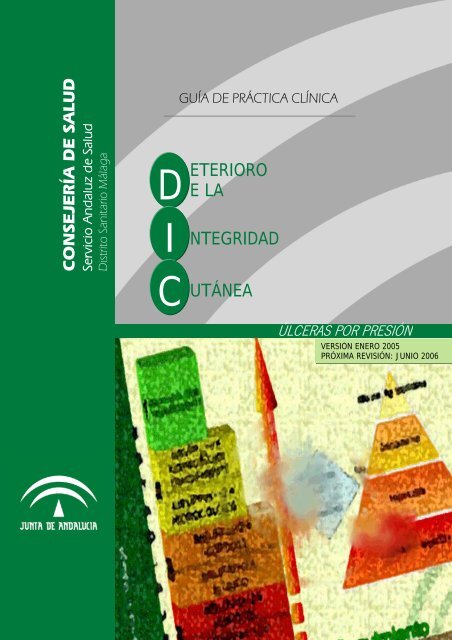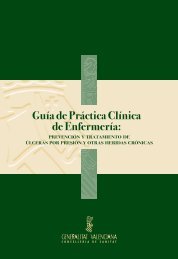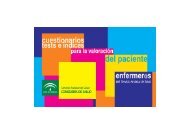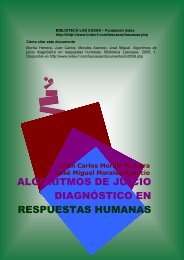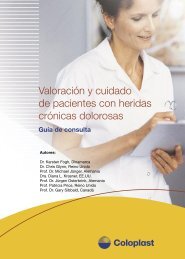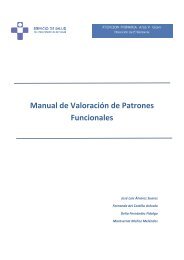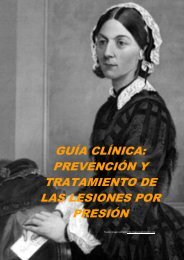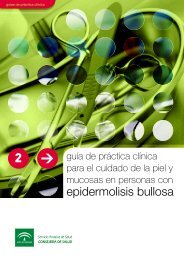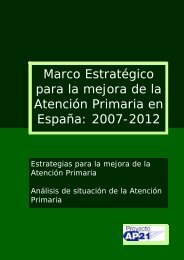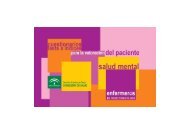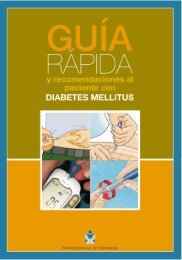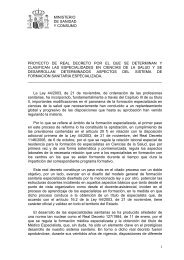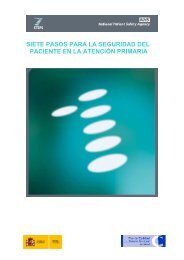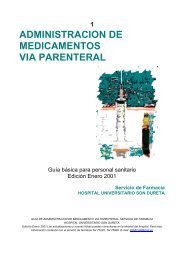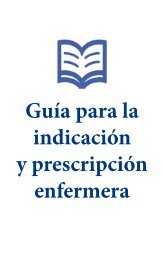Deterioro de la Integridad Cutánea. - Úlceras.net
Deterioro de la Integridad Cutánea. - Úlceras.net
Deterioro de la Integridad Cutánea. - Úlceras.net
You also want an ePaper? Increase the reach of your titles
YUMPU automatically turns print PDFs into web optimized ePapers that Google loves.
2◣ Guía <strong>de</strong> Práctica Clínica para el Manejo <strong>de</strong>l <strong>Deterioro</strong> <strong>de</strong> <strong>la</strong> <strong>Integridad</strong> <strong>Cutánea</strong>: <strong>Úlceras</strong> por Presión◢Distrito Sanitario Má<strong>la</strong>ga 2004C/ Sevil<strong>la</strong>, 2329009 Má<strong>la</strong>gaDepósito Legal MA-PROHIBIDA SU REPRODUCCIÓN TOTAL O PARCIAL POR CUALQUIER MEDIO, SIN AUTORIZACIÓNPREVIA DEL DISTRITO SANITARIO MÁLAGADETERIORO DE LAINTEGRIDADCUTÁNEA:ÚLCERAS PORPRESIÓNGuías <strong>de</strong> Práctica ClínicaDistrito Sanitario Má<strong>la</strong>ga
AUTORESJUAN CARLOS MORILLA HERRERA Director Unidad De Resi<strong>de</strong>ncias DS Má<strong>la</strong>gaFRANCISCO JAVIER MARTIN SANTOS Coordinador <strong>de</strong> Enfermería DS Má<strong>la</strong>gaJUAN BLANCO MORGADO Adjunto a <strong>la</strong> Coordinación <strong>de</strong> Enfermería DS Má<strong>la</strong>gaJOSÉ MIGUEL MORALES ASENCIO Responsable <strong>de</strong> Efectividad e Investigación DS Má<strong>la</strong>gaPANEL DE REVISIÓNMATILDE AREVALO LINARES CS Portada AltaINMACULADA ARRANZ MONTES CS Puerto <strong>de</strong> <strong>la</strong> TorreSONIA BUENO PEREZ CS Cruz Humil<strong>la</strong><strong>de</strong>roTRINIDAD CAMPOS HERRERA CS HuelinJULIO DE LA TORRE ROVIRA CS ChurrianaDAVID DIAZ FERNANDEZ CS MirafloresISABEL MARIA GALLEGO GUTIERREZ CS Nueva Má<strong>la</strong>gaMª ALLENDE GARCIA LOPE CS El PaloALFONSO GARCIA GUERRERO CS Puerta B<strong>la</strong>ncaJOSE MIGUEL GOMEZ COIDURAS CS TrinidadANTONIA LÓPEZ LEÓN CS Unidad <strong>de</strong> Resi<strong>de</strong>nciasMANUEL LUQUE LOPEZ CS DeliciasJUAN JOSE MERINO CARRILLO CS Campanil<strong>la</strong>sMARIA CARMEN MORENO VÁZQUEZ CS A<strong>la</strong>meda-PerchelMª JOSE MOTTO DE FRANCISCO CS MirafloresASUNCIÓN PONCE PÉREZ CS La LuzMª TERESA PUEBLA ARGANDOÑA CS La LuzMILAGROS REYES SANCHEZ CS Nueva Má<strong>la</strong>gaFRANCISCO SALIDO PUERTAS CS Ciudad JardínJOSE LUIS SANCHEZ DEL CAMPO CS Cruz Humil<strong>la</strong><strong>de</strong>roFRANCISCA SANTOS VILLALOBOS CS Tiro PichónMARIA JESÚS SESE GARCÍA CS Rincón <strong>de</strong> <strong>la</strong> VictoriaTOMÁS AMORES JORQUERA CS San Andrés-TorcalMARTA VILA CLAVERO CS LimonarFRANCISCA VILLA ESTRADA CS CapuchinosMARIA <strong>de</strong>l MAR YAGÜES FERNANDEZ CS Portada AltaCASILDA ORTEGA DE LA CRUZ Farmacéutica DS Má<strong>la</strong>gaCARMEN SUÁREZ ALEMÁN Farmacéutica DS Má<strong>la</strong>gaAUTORES DE LAS RECOMENDACIONES PARA PACIENTES Y CUIDADORASDOLORES ALEJANDRO MAZILLI CS La LuzÁNGEL D SAAVEDRA VALDAYO CS La Luz3DETERIORO DE LAINTEGRIDADCUTÁNEA:ÚLCERAS PORPRESIÓNGuías <strong>de</strong> Práctica ClínicaDistrito Sanitario Má<strong>la</strong>ga
íNDICEIntroducción....................................................................................................5Prevención ......................................................................................................9Valoración <strong>de</strong>l riesgo .................................................................................10Estadíos <strong>de</strong> <strong>la</strong> úlcera ..................................................................................11Esca<strong>la</strong>s <strong>de</strong> valoración .................................................................................12Valoración global.......................................................................................13Seguimiento...............................................................................................15Intervenciones preventivas........................................................................17Algoritmos.....................................................................................................27P<strong>la</strong>n <strong>de</strong> Cuidados: <strong>Deterioro</strong> <strong>de</strong> <strong>la</strong> <strong>Integridad</strong> <strong>Cutánea</strong>.................................37Tratamiento...................................................................................................21Información para pacientes y cuidadoras......................................................42Referencias....................................................................................................454DETERIORO DE LAINTEGRIDADCUTÁNEA:ÚLCERAS PORPRESIÓNGuías <strong>de</strong> Práctica ClínicaDistrito Sanitario Má<strong>la</strong>ga
5introducciónDETERIORO DE LAINTEGRIDADCUTÁNEA:ÚLCERAS PORPRESIÓNGuías <strong>de</strong> Práctica ClínicaDistrito Sanitario Má<strong>la</strong>ga
El <strong>de</strong>terioro <strong>de</strong> <strong>la</strong> integridad cutánea es un diagnóstico incluido en <strong>la</strong> NANDA <strong>de</strong>s<strong>de</strong> sus inicios yabarca una multitud <strong>de</strong> posibles situaciones que se dan en <strong>la</strong> clínica diaria, que no siemprerequieren el mismo abordaje. En el caso <strong>de</strong> <strong>la</strong>s úlceras por presión (UPPs), es precisamente don<strong>de</strong>se da mayor variabilidad <strong>de</strong> <strong>la</strong> práctica enfermera, tanto en <strong>la</strong> valoración, como en <strong>la</strong> prevención ytratamiento <strong>de</strong> <strong>la</strong>s mismas 1 .Los estudios epi<strong>de</strong>miológicos sobre <strong>la</strong>s UPPs en nuestro país no han sido realizados hasta hacepoco tiempo y arrojan cifras preocupantes:En el realizado en <strong>la</strong> comunidad <strong>de</strong> La Rioja, afectan a más <strong>de</strong> un 12% <strong>de</strong> <strong>la</strong> pob<strong>la</strong>ciónatendida en un centro hospita<strong>la</strong>rio o socio-sanitario y a más <strong>de</strong>l 0,27% <strong>de</strong> los mayores <strong>de</strong>65 años. En este grupo es don<strong>de</strong> se encuentran el 45,8% <strong>de</strong> todos los pacientes conUPP, generalmente ancianos entre los 76 y 80 años. Cerca <strong>de</strong> un 50% <strong>de</strong> estas lesionesse encuentran en estadíos III o IV y con una antigüedad media <strong>de</strong> más <strong>de</strong> 170 días <strong>de</strong>evolución 2 .En <strong>la</strong> provincia <strong>de</strong> Cáceres se han <strong>de</strong>tectado prevalencias en Atención Primaria <strong>de</strong> hasta4-6 pacientes por cada 10.000 habitantes, incrementándose el valor hasta 22-26 porcada 10.000 habitantes en pob<strong>la</strong>ción mayor <strong>de</strong> 65 años 3 .Más recientemente, los datos <strong>de</strong>l Estudio Nacional <strong>de</strong> Prevalencia <strong>de</strong> UPPs aportan unaprevalencia media en Atención Primaria <strong>de</strong> un 8,34% entre los pacientes que recibíanatención domiciliaria, un 0,54% <strong>de</strong> los mayores <strong>de</strong> 65 años y un 0,11% <strong>de</strong> los mayores <strong>de</strong>14 años. A nivel hospita<strong>la</strong>rio fue <strong>de</strong>l 8,81% (con un valor mínimo <strong>de</strong>l 0% y un valormáximo <strong>de</strong>l 45,45%) y en el nivel socio-sanitario <strong>de</strong> 7,6% 4 . No obstante, <strong>la</strong> baja tasa <strong>de</strong>respuestas <strong>de</strong> los cuestionarios <strong>de</strong> este estudio, hace pensar que probablemente <strong>la</strong>frecuencia <strong>de</strong>l problema sea aún mayor.En el Distrito Má<strong>la</strong>ga, en <strong>la</strong> auditoría <strong>de</strong> 2001, con <strong>la</strong>s limitaciones <strong>de</strong> inferenciaepi<strong>de</strong>miológica que implica una recogida retrospectiva <strong>de</strong> datos, <strong>la</strong> prevalencia <strong>de</strong> UPPsen el domicilio fue <strong>de</strong>l 3,04%, lo que invita a pensar que realmente esta cifra sería muchomayor en un estudio transversal <strong>de</strong> base pob<strong>la</strong>cional.6Por tanto, <strong>la</strong> sinergia <strong>de</strong> un problema frecuente con una alta variabilidad <strong>de</strong> <strong>la</strong> práctica clínica y <strong>la</strong>profusión <strong>de</strong> intervenciones y productos <strong>de</strong> dudoso beneficio, genera el caldo <strong>de</strong> cultivo idóneo para<strong>la</strong> instauración <strong>de</strong> prácticas inefectivas que, como consecuencia, no tras<strong>la</strong>dan ningún beneficio a <strong>la</strong>pob<strong>la</strong>ción.DETERIORO DE LAINTEGRIDADCUTÁNEA:ÚLCERAS PORPRESIÓNGuías <strong>de</strong> Práctica ClínicaDistrito Sanitario Má<strong>la</strong>ga
OBJETIVOS Y DESTINATARIOS DE LA GUÍAEl propósito <strong>de</strong> esta guía <strong>de</strong> actuación clínica es servir <strong>de</strong> ayuda para <strong>la</strong> toma <strong>de</strong> <strong>de</strong>cisiones <strong>de</strong>profesionales, pacientes y cuidadoras en el marco <strong>de</strong> Atención Primaria, con el objetivo <strong>de</strong> ofrecer<strong>la</strong>s intervenciones basadas en el mejor conocimiento disponible y aumentar <strong>la</strong> efectividad <strong>de</strong> loscuidados prestados a personas con riesgo <strong>de</strong> <strong>de</strong>terioro <strong>de</strong> <strong>la</strong> integridad cutánea o existencia real <strong>de</strong>lproblema.ELABORACIÓNPara su e<strong>la</strong>boración se ha utilizado <strong>la</strong> metodología <strong>de</strong> panel <strong>de</strong> expertos en dos fases: una primeraen <strong>la</strong> que un grupo <strong>de</strong> expertos clínicos, en gestión, en efectividad clínica y farmacéuticos diseñaron<strong>la</strong> adaptación <strong>de</strong> <strong>la</strong>s recomendaciones <strong>de</strong> <strong>la</strong>s guías <strong>de</strong> Práctica Clínica <strong>de</strong> <strong>la</strong> Universidad <strong>de</strong>l Iowa 5, 6 ,<strong>de</strong> <strong>la</strong> Agency for Health Research & Quality estadouni<strong>de</strong>nse 7 , <strong>de</strong>l Royal College of Nursing británico 8 ,<strong>de</strong>l European Pressure Ulcer Advisory Panel 9 , <strong>de</strong> <strong>la</strong> Wound, Ostomy and Continence Nurses Society(WONC) 10 , <strong>de</strong> <strong>la</strong> Registered Nurses Association of Ontario 11 , <strong>de</strong>l Grupo Nacional para el Estudio yAsesoramiento en <strong>Úlceras</strong> por Presión <strong>de</strong>l Nacional Institute for Clinical Excellence 12 y <strong>de</strong> <strong>la</strong>srevisiones sistemáticas disponibles en <strong>la</strong> base <strong>de</strong> datos Cochrane, así como <strong>de</strong> <strong>la</strong> Agencia <strong>de</strong>Evaluación <strong>de</strong> Tecnologías Sanitarias <strong>de</strong>l Instituto <strong>de</strong> Salud Carlos III 13 . Para aquel<strong>la</strong>s áreas <strong>de</strong>incertidumbre que no figuraban en estas fuentes, se han utilizado recomendaciones <strong>de</strong> los ensayosclínicos disponibles.Una vez finalizada esta fase, se procedió a su revisión mediante metodología activo-participativa enun taller <strong>de</strong> expertos proce<strong>de</strong>ntes <strong>de</strong> los Centros en los que va a ser aplicada, en <strong>la</strong> que se refinaronalgunos conceptos y se diseñó <strong>la</strong> estrategia <strong>de</strong> difusión, implementación y evaluación.7DETERIORO DE LAINTEGRIDADCUTÁNEA:ÚLCERAS PORPRESIÓNESTRATEGIAS DE DIFUSIÓN E IMPLEMENTACIÓNPara <strong>la</strong> diseminación <strong>de</strong> <strong>la</strong>s recomendaciones y su aplicación en <strong>la</strong> práctica clínica diaria seutilizarán intervenciones multicomponente, <strong>de</strong> cara a potenciar <strong>la</strong>s garantías <strong>de</strong> consolidación <strong>de</strong> <strong>la</strong>smismas.Diseminación Designación <strong>de</strong> responsables <strong>de</strong> <strong>la</strong> implementación en cada centro Envío por escrito a cada responsable y a cada Adjunto <strong>de</strong> Enfermería <strong>de</strong> los Centros <strong>de</strong> Salud Presentación institucional al Distrito, a otros Distritos, Hospitales e instituciones (Universidad, Socieda<strong>de</strong>scientíficas, Colegios Profesionales, etc), asociaciones <strong>de</strong> pacientes y entida<strong>de</strong>s afines (Asociación <strong>de</strong>cuidadoras <strong>de</strong> Má<strong>la</strong>ga, CUDECA, Asociación <strong>de</strong> Familiares <strong>de</strong> Enfermos <strong>de</strong> Alzheimer…) Medios <strong>de</strong> difusión escritos: a profesionales (envío <strong>de</strong> 1 ejemp<strong>la</strong>r a cada profesional, junto con una tab<strong>la</strong>con <strong>la</strong>s recomendaciones y algoritmos principales, a<strong>de</strong>más <strong>de</strong> carteles con <strong>la</strong>s principalesrecomendaciones para los centros <strong>de</strong> Salud), a usuarios (folletos informativos y educativos paraGuías <strong>de</strong> Práctica ClínicaDistrito Sanitario Má<strong>la</strong>ga
cuidadoras <strong>de</strong> pacientes con <strong>de</strong>terioro <strong>de</strong> <strong>la</strong> movilidad real o potencial y carteles informativos en <strong>la</strong>s sa<strong>la</strong>s<strong>de</strong> espera <strong>de</strong> los Centros <strong>de</strong> Salud). Difusión electrónica: remisión a <strong>la</strong> Intra<strong>net</strong> <strong>de</strong>l Sistema Sanitario Público Andaluz y webs <strong>de</strong> entida<strong>de</strong>sprofesionales interesadasImplementación Taller <strong>de</strong> formación-revisión, con metodología activo-participativa, para los imp<strong>la</strong>ntadores <strong>de</strong> <strong>la</strong> Guía enlos Centros, acreditado por <strong>la</strong> Agencia <strong>de</strong> Calidad Sanitaria Reconocimiento formal <strong>de</strong> <strong>la</strong> figura <strong>de</strong>l imp<strong>la</strong>ntador: inclusión en contrato programa 2005 <strong>de</strong> objetivosre<strong>la</strong>cionados con <strong>la</strong> imp<strong>la</strong>ntación <strong>de</strong> <strong>la</strong> Guía, introductor <strong>de</strong> <strong>la</strong> presentación formal en los Centros <strong>de</strong>Salud, responsables <strong>de</strong> <strong>la</strong>s microauditorías <strong>de</strong> indicadores <strong>de</strong> <strong>la</strong> Guía y conductores <strong>de</strong> sesiones clínicasen el Centro, sobre casos re<strong>la</strong>cionados con <strong>la</strong> toma <strong>de</strong> <strong>de</strong>cisiones <strong>de</strong> áreas incluidas en <strong>la</strong> Guía,vincu<strong>la</strong>ción al Programa <strong>de</strong> Gestión <strong>de</strong> Riesgos Sanitarios <strong>de</strong>l Distrito Sanitario Má<strong>la</strong>ga. Auditoría+ Información e implicación <strong>de</strong> ciudadanos Se analizarán a lo <strong>la</strong>rgo <strong>de</strong> 2005 intervenciones con alumnos en el pregrado, mediante implementación<strong>de</strong> recomendaciones en <strong>la</strong> Universidad en disciplinas <strong>de</strong> Ciencias <strong>de</strong> <strong>la</strong> Salud y <strong>la</strong> instauración <strong>de</strong>recordatorios electrónicos en <strong>la</strong> aplicación DIRAYA.NIVEL DE EVIDENCIA DE LAS RECOMENDACIONESPara <strong>la</strong> gradación <strong>de</strong> <strong>la</strong>s recomendaciones, se ha utilizado <strong>la</strong> misma que propone <strong>la</strong> Guía <strong>de</strong> Iowa:ABCDRECOMENDACIÓN PROCEDENTE DE RESULTADOS DE REVISIONESSISTEMÁTICAS, METAANÁLISIS DE ENSAYOS CLÍNICOSRECOMENDACIÓN PROCEDENTE DE RESULTADOS DE ESTUDIOSEXPERIMENTALES Y CONTROLADOS, CON O SIN ALEATORIZACIÓN, CONRESULTADOS QUE AVALAN CONSISTENTEMENTE UNA ACCIÓN ESPECÍFICARECOMENDACIÓN PROCEDENTE DE ESTUDIOS OBSERVACIONALES O ENSAYOSCLÍNICOS CON RESULTADOS INCONSISTENTESRECOMENDACIÓN PROCEDENTE DE GRUPOS DE EXPERTOS O INFORMES DESERIES DE CASOS8DETERIORO DE LAINTEGRIDADCUTÁNEA:ÚLCERAS PORPRESIÓNGuías <strong>de</strong> Práctica ClínicaDistrito Sanitario Má<strong>la</strong>ga
9DETERIORO DE LAINTEGRIDADCUTÁNEA:ÚLCERAS PORPRESIÓNPrevenciónGuías <strong>de</strong> Práctica ClínicaDistrito Sanitario Má<strong>la</strong>ga
VALORACIÓNLa mayoría <strong>de</strong> UPPs son evitables; es una cuestión <strong>de</strong> instauración precoz <strong>de</strong> medidas preventivasque, realizadas correctamente, aportan un efecto protector lo suficientemente efectivo 14 .CUALQUIER PERSONA EN RIESGO DEBERÁ SER VALORADA PARAESTABLECER EL ESTADO DE INTEGRIDAD CUTÁNEA EN TODA SUSUPERFICIE CORPORAL. ESTA VALORACIÓN DEBERÁ HACERSESISTEMÁTICAMENTE EN LA PRIMERA VISITA DOMICILIARIA O EN ELPRIMER CONTACTO DE LA PERSONA CON SU ENFERMERA DE FAMILIA, OBIEN, EN LA DERIVACIÓN O TRANSICIÓN A OTRO ENTORNO DECUIDADOS, O ANTE CUALQUIER CAMBIO EN SU ESTADO DE SALUDCDiferentes investigaciones han puesto en evi<strong>de</strong>ncia algunos factores que sitúan a <strong>la</strong>s personas enriesgo <strong>de</strong> pa<strong>de</strong>cer úlceras <strong>de</strong> presión:FACTORES EXTRÍNSECOS1. Excesiva exposición a <strong>la</strong> humedad (incontinencia, transpiración, exudado <strong>de</strong> heridas)2. Pacientes sometidos a fricción y mecanismos <strong>de</strong> cizal<strong>la</strong>miento (incapaces <strong>de</strong> estirar por simismos <strong>la</strong> cama, pacientes con movimientos involuntarios que causan fricción contra <strong>la</strong>ssabanas).FACTORES INTRÍNSECOS3. Edad avanzada4. Antece<strong>de</strong>ntes <strong>de</strong> <strong>de</strong>terioro <strong>de</strong> <strong>la</strong> integridad cutánea5. Personas con <strong>de</strong>terioro <strong>de</strong> <strong>la</strong> movilidad (en cualquiera <strong>de</strong> sus modalida<strong>de</strong>s)6. Personas con riesgo o presencia <strong>de</strong> <strong>de</strong>sequilibrio nutricional por <strong>de</strong>fecto.7. Personas con déficit <strong>de</strong> volumen <strong>de</strong> líquidos8. Personas con trastornos <strong>de</strong> <strong>la</strong> percepción sensorial (táctil, nociceptiva, disminución <strong>de</strong>l nivel <strong>de</strong>consciencia…)9. Presencia <strong>de</strong> enfermedad vascu<strong>la</strong>r10. Enfermedad terminal10DETERIORO DE LAINTEGRIDADCUTÁNEA:ÚLCERAS PORPRESIÓNGuías <strong>de</strong> Práctica ClínicaDistrito Sanitario Má<strong>la</strong>ga
ESTADÍOS DE LA ÚLCERASe realizará una valoración <strong>de</strong> cabeza a pies, para <strong>de</strong>terminar estadíos <strong>de</strong> <strong>la</strong> piel. El estadiaje <strong>de</strong> <strong>la</strong>sUPPs se c<strong>la</strong>sifica en 4 niveles:Grado I: Se caracteriza por eritema que no <strong>de</strong>saparece con <strong>la</strong> presión yanuncia el inicio <strong>de</strong> <strong>la</strong> úlcera <strong>de</strong> presión. En los individuos con <strong>la</strong> piel másoscura, el <strong>de</strong>co<strong>la</strong>ramiento <strong>de</strong> <strong>la</strong> piel, el calor mo<strong>de</strong>rado, el e<strong>de</strong>ma, <strong>la</strong>induración o <strong>la</strong> dureza pue<strong>de</strong>n servir <strong>de</strong> indicadores. La <strong>de</strong>finición según<strong>la</strong> National Pressure Ulcer Advisory Panel (NPUAP) status 15 : es un estado<strong>de</strong> <strong>la</strong> piel sometida a <strong>la</strong> presión que aún está intacta pero que presenta encomparación con <strong>la</strong> piel adyacente alguno <strong>de</strong> los siguientes cambios:calor mo<strong>de</strong>rado o frialdad, consistencia empastada o e<strong>de</strong>matizada y/osensación <strong>de</strong> dolor o comezón. La úlcera aparece como un área <strong>de</strong>finida<strong>de</strong> rojez persistente o ligeramente pigmentada <strong>de</strong> rojo, azul o colorespurpúreos en los tonos <strong>de</strong> piel más oscura.Grado II: La pérdida parcial <strong>de</strong>l espesor, que involucra epi<strong>de</strong>rmis, <strong>de</strong>rmiso ambos (por ejemplo <strong>la</strong> abrasión, ampol<strong>la</strong>, o el cráter poco profundo).Grado III: La úlcera es más profunda y afecta a <strong>la</strong> totalidad <strong>de</strong> <strong>la</strong> <strong>de</strong>rmis yal tejido subcutáneo, pudiendo afectar también a <strong>la</strong> fascia muscu<strong>la</strong>r perono más allá.Grado IV: La lesión se extien<strong>de</strong> hasta el músculo, hueso o estructurasadyacentes, tendón, nervios. En este estadio <strong>la</strong>s úlceras pue<strong>de</strong>ncomplicarse con graves infecciones.11DETERIORO DE LAINTEGRIDADCUTÁNEA:ÚLCERAS PORPRESIÓNGuías <strong>de</strong> Práctica ClínicaDistrito Sanitario Má<strong>la</strong>ga
ESCALAS DE VALORACIÓN DEL RIESGODe los múltiples instrumentos existentes para evaluar el riesgo <strong>de</strong> úlceras por presión, ninguno ha <strong>de</strong>mostradoen estudios sólidos <strong>la</strong> superioridad al juicio <strong>de</strong> <strong>la</strong> enfermera en <strong>la</strong> predicción. La esca<strong>la</strong> <strong>de</strong> Bra<strong>de</strong>n ha sido <strong>la</strong>más evaluada y pue<strong>de</strong> ayudar a estimar el nivel <strong>de</strong> riesgo <strong>de</strong> <strong>de</strong>sarrol<strong>la</strong>r úlceras <strong>de</strong> presión en los pacientes.Investigaciones previas indican que los pacientes con puntuaciones <strong>de</strong> 16 o menores <strong>de</strong>sarrol<strong>la</strong>raninminentemente una úlcera <strong>de</strong> presión, puntuaciones por <strong>de</strong>bajo <strong>de</strong> 18 indican riesgo <strong>de</strong> ulceración. Sinembargo, como con otras herramientas, <strong>la</strong> fiabilidad y vali<strong>de</strong>z <strong>de</strong>l Bra<strong>de</strong>n pue<strong>de</strong> variar según los escenarios, porlo que <strong>la</strong> valoración regu<strong>la</strong>r <strong>de</strong> <strong>la</strong> piel en busca <strong>de</strong> señales tempranas <strong>de</strong> lesión <strong>de</strong> presión es un añadidoesencial para evitar riesgos.SE UTILIZARÁ PARA LA VALORACIÓN DEL RIESGO, COMO INSTRUMENTOCOMPLEMENTARIO, LA ESCALA DE BRADEN 16CCUANDO LA VALORACIÓN DEL RIESGO RECAIGA FUNDAMENTALMENTEEN CUIDADORAS INFORMALES O DE RESIDENCIAS DE ANCIANOS, SEINDICARÁ LA UTILIZACIÓN DE LA ESCALA DE NORTON, POR SU MAYORSIMPLICIDADLA VALORACIÓN DEL RIESGO NO SUSTITUYE, SINO QUE COMPLEMENTALA VALORACIÓN GLOBAL DE NECESIDADES DE LA PERSONA Y NUNCADEBER REALIZARSE DE FORMA AISLADA DE OTRAS CIRCUNSTANCIASCLÍNICASNO EXISTEN DATOS SÓLIDOS QUE AVALEN EL USO DE LAS ESCALAS DEVALORACIÓN DEL RIESGO DE ÚLCERAS POR PRESIÓN COMOINSTRUMENTOS DE CRIBADO 17DCA12DETERIORO DE LAINTEGRIDADCUTÁNEA:ÚLCERAS PORPRESIÓNGuías <strong>de</strong> Práctica ClínicaDistrito Sanitario Má<strong>la</strong>ga
VALORACIÓN GLOBALLa Valoración general <strong>de</strong>berá incluir el estado actual <strong>de</strong> salud y posibles enfermeda<strong>de</strong>sconcomitantes. La Valoración por necesida<strong>de</strong>s <strong>de</strong>berá cubrir, como mínimo, los siguientes aspectos(<strong>la</strong> valoración <strong>de</strong> <strong>la</strong> integridad cutánea se excluye <strong>de</strong> este apartado):Alimentarse eHidratarseMoverse ymantener posturaa<strong>de</strong>cuadaEliminaciónEvitar peligrosCreencias yValoresMantener Tªa<strong>de</strong>cuadaComunicarse yRe<strong>la</strong>cionarseApren<strong>de</strong>rTrabajar yrealizarseVestirse yarreg<strong>la</strong>rse ESTADO NUTRICIONAL NIVEL DE HIDRATACIÓN CAPACIDAD AUTOCUIDADO NIVEL DE MOVILIDAD (en cama, en sil<strong>la</strong> <strong>de</strong>ruedas, sentado…) DEAMBULACIÓN PATRÓN DE ELIMINACIÓN URINARIA PATRÓN DE ELIMINACIÓN FECAL CAPACIDAD AUTOCUIDADO NIVEL DE DOLOR SITUACIÓN INMUNOLÓGICA AFRONTAMIENTO CREENCIAS SOBRE SALUD IMAGINACIONES SOBRE UPPs Y SU TTO CAPACIDAD DE REGULAR Tª EN FUNCIÓN DELENTORNO Y DE LA Tª CORPORAL SENSOPERCEPCIÓN MOTIVACIÓN DE LA PERSONA POR LACURACIÓN DE SU/S ÚLCERA/S CAPACIDAD INTELECTUAL Y DE INTEGRACIÓNDE CONOCIMIENTOS RELACIONADOS IMAGEN CORPORAL ROL CAPACIDAD DE AUTOCUIDADOMNA/MAST0602: Hidratación (01-03)Índice <strong>de</strong> Barthel02: Posición corporalÍndice <strong>de</strong> BarthelEn el cuidador, se valorará <strong>la</strong> capacidad <strong>de</strong> <strong>de</strong>sempeño <strong>de</strong>l rol <strong>de</strong> cuidador.0502: Continencia Urinaria0500: Continencia IntestinalÍndice <strong>de</strong> Barthel2102: Nivel <strong>de</strong> dolor0702: Estado Inmunológico (01-11)1302: Afrontamiento1704: Creencias sobre salud:amenazas percibidas2400: Función sensorial: cutánea2404: Función sensorial: visión1609: Conducta terapéutica:enfermedad o lesión1606: Participación: <strong>de</strong>cisionessobre el cuidado <strong>de</strong> salud0900: Capacidad cognitiva1200: Imagen corporal1205: AutoestimaÍndice <strong>de</strong> Barthel13DETERIORO DE LAINTEGRIDADCUTÁNEA:ÚLCERAS PORPRESIÓNGuías <strong>de</strong> Práctica ClínicaDistrito Sanitario Má<strong>la</strong>ga
ESCALA DE BRADENSENSOPERCEPCIÓN: Capacidad <strong>de</strong> respon<strong>de</strong>r significativamente a <strong>la</strong>s alteraciones en el bienestar re<strong>la</strong>cionadas con <strong>la</strong> UPP1234Completamente limitada: No respon<strong>de</strong> a estímulo doloroso por disminución <strong>de</strong>l nivel <strong>de</strong> consciencia o sedaciónincapacidad <strong>de</strong> sentir dolor en <strong>la</strong> mayor parte <strong>de</strong>l cuerpoMuy limitada: Respon<strong>de</strong> tan solo a estímulo doloroso. No pue<strong>de</strong> comunicar alteraciones en el bienestar excepto por <strong>la</strong> <strong>de</strong>privación <strong>de</strong>sueño/reposo y gemidosIncapacidad <strong>de</strong> sentir dolor en el 50% <strong>de</strong>l cuerpo.Mo<strong>de</strong>radamente limitada: respon<strong>de</strong> a ór<strong>de</strong>nes verbales pero no siempre pue<strong>de</strong> comunicar dolor o incomodidad que necesita sercambiado <strong>de</strong> posiciónTiene alguna alteración sensorial que limita su capacidad <strong>de</strong> percibir dolor o disconfort en 1 ó 2 extremida<strong>de</strong>sSin alteraciones: Respon<strong>de</strong> a ór<strong>de</strong>nes verbales. No tiene déficits sensitivos que pudiesen limitar su capacidad para sentirVerbaliza dolor o incomodidadHUMEDAD: Grado <strong>de</strong> exposición <strong>de</strong> <strong>la</strong> piel a <strong>la</strong> humedadConstantemente húmeda: <strong>la</strong> piel está húmeda permanentemente por <strong>la</strong> perspiración, orina, etc. Se <strong>de</strong>tecta humedad cada vez que el1paciente es sometido a un cambio postural o movilización.2 Húmeda: <strong>la</strong> piel está a menudo húmeda pero no siempre. Necesita cambios <strong>de</strong> sábanas al menos una vez por turno.3 Humedad ocasional: <strong>la</strong> piel está mojada a veces, requiriendo un cambio <strong>de</strong> sábanas estraordinario al día.4 Humedad infrecuente: <strong>la</strong> piel está habitualmente seca, precisando cambios <strong>de</strong> sábana rutinarios.ACTIVIDAD: Grado e actividad física1 Postrado en cama2 Postrado en sillón: incapacidad <strong>de</strong> caminar. No pue<strong>de</strong> soportar su propio peso.3 Deambu<strong>la</strong> ocasionalmente durante el día pequeñas distancias con o sin ayuda. Pasa <strong>la</strong> mayor parte <strong>de</strong>l turno en cama o sillónCamina con frecuencia: camina por el exterior <strong>de</strong> <strong>la</strong> habitación al menos dos veces al día y en el interior <strong>de</strong> <strong>la</strong> misma al menos una vez4cada dos horasMOVILIDAD: Capacidad <strong>de</strong> cambiar y contro<strong>la</strong>r <strong>la</strong> posición corporal1 Completamente inmóvil: No realiza ni siquiera pequeños cambios <strong>de</strong> posición en el cuerpo o extremida<strong>de</strong>s sin ayuda23Muy limitada: hace leves cambios ocasionales en <strong>la</strong> posición corporal o <strong>de</strong> extremida<strong>de</strong>s pero es incapaz <strong>de</strong> hacer cambios frecuenteso significativos <strong>de</strong> forma in<strong>de</strong>pendienteLevemente limitada: hace cambios frecuentes aunque muy leves en <strong>la</strong> posición corporal o <strong>de</strong> <strong>la</strong>s extremida<strong>de</strong>s <strong>de</strong> forma in<strong>de</strong>pendiente4 Sin limitaciones: realiza cambios importantes y frecuentes en <strong>la</strong> posición corporal sin ayuda.NUTRICIÓN: Patrón habitual <strong>de</strong> ingestaMuy pobre: nunca ingiere una comida completa. Rara vez come más <strong>de</strong> 1/3 <strong>de</strong> <strong>la</strong> comida ofrecida. Come 2 suplementos o menos <strong>de</strong>1 proteínas al día(carne o lácteos). Ingiere líquidos escasamente. No toma suplementos dietéticosDieta absoluta y/o exclusivamente con fluidoterapia durante más <strong>de</strong> 5 díasProbablemente ina<strong>de</strong>cuada: raras veces come una comida completa y generalmente como solo <strong>la</strong> mitad <strong>de</strong> los que se le ofrece. La2 ingesta protéica incluye sólo 3 aportes <strong>de</strong> carne o lácteos al día. Ocasionalmente toma suplemento dietético líquido.Recibe líquidos por <strong>de</strong>bajo <strong>de</strong> <strong>la</strong> cantidad optima o por sondaA<strong>de</strong>cuada: come más <strong>de</strong> <strong>la</strong> mitad <strong>de</strong> <strong>la</strong> mayoría <strong>de</strong> <strong>la</strong>s comidas. Come un total <strong>de</strong> 4 aportes protéicos (carne o lácteos). Rehúsa3 ocasionalmente una comida, pero toma suplementos dietéticos si se le ofrecen.NPT o NEExcelente: come <strong>la</strong> mayor parte <strong>de</strong> <strong>la</strong>s comidas. Nunca rehúsa una comida. Come un total <strong>de</strong> 4 ó más aportes protéicos al día.4Ocasionalmente come entre comidas. No requiere suplementso dietéticos.FUERZAS DE CIZALLAMIENTOProblema: Requiere asistencia mo<strong>de</strong>rada-máxima para moverse. Es imposible elevarlo sin <strong>de</strong>slizarlo contra <strong>la</strong>s sábanas. Se <strong>de</strong>sliza1 con frecuencia en <strong>la</strong> cama o el sillón, requiriendo restaurar <strong>la</strong> posición <strong>de</strong> su cuerpo con ayuda total. Espasticidad, contracturas o <strong>la</strong>agitación le producen una fricción constante.Problema potencial: Se mueve con soltura o requiere mínima ayuda. Durante un movimiento es posible que <strong>la</strong> piel se <strong>de</strong>slice contra2 <strong>la</strong>s sábanas, el sillón, <strong>la</strong>s sujeciones mecánicas y otros dispositivos. Mantiene re<strong>la</strong>tivamente una buena posición en el sillón o <strong>la</strong> cama<strong>la</strong> mayoría <strong>de</strong>l tiempo, aunque en ocasiones, se resba<strong>la</strong>.No presenta problemas aparentes: se mueve en <strong>la</strong> cama y el sillón <strong>de</strong> forma in<strong>de</strong>pendiente y tiene suficiente fuerza muscu<strong>la</strong>r para3elevarse durante <strong>la</strong> movilización. Mantiene un postura a<strong>de</strong>cuada en el sillón o <strong>la</strong> cama durante todo el tiempo.14DETERIORO DE LAINTEGRIDADCUTÁNEA:ÚLCERAS PORPRESIÓNGuías <strong>de</strong> Práctica ClínicaDistrito Sanitario Má<strong>la</strong>ga
SEGUIMIENTODebería usarse un instrumento <strong>de</strong> valoración <strong>de</strong>l riesgo para monitorizar<strong>la</strong> <strong>la</strong> <strong>de</strong>saparición,persistencia o aumento <strong>de</strong> factores <strong>de</strong> riesgo <strong>de</strong> <strong>la</strong> persona. Según el escenario, <strong>la</strong> periodicidad <strong>de</strong> <strong>la</strong>sreevaluaciones <strong>de</strong>bería ser:RESIDENCIAS DE ANCIANOS REEVALUACIÓN CADA 48 HORAS DURANTE LAPRIMERA SEMANA, SEMANALMENTE DURANTE UN MES, TRIMESTRALMENTEDESPUÉS O MÁS FRECUENTEMENTE SI HAY CAMBIOS 1EN EL ÁMBITO DOMICILIARIO UNA VALORACIÓN SUPERFICIAL DE LA PIEL DEBEPRACTICARSE EN CADA VISITA Y DEBE INSTRUIRSE AL CUIDADOR EN LAVALORACIÓN DE LA PIEL (ESCALA DE NORTON).EN PACIENTES CON DETERIORO DE LA MOVILIDAD EN CAMA, DEBERÁINCREMENTARSE LA FRECUENCIA DE VALORACIONES. PARA ELLO, SEUTILIZARÁN LOS SIGUIENTES CRITERIOS: LA NOC PREPARACIÓN DEL CUIDADORFAMILIAR Y EL VALOR DE LA ESCALA DE VALORACIÓN DE RIESGO QUE SE HAYAUTILIZADOPREPARACIÓN DEL VALOR DE E. DECUIDADOR FAMILIAR RIESGO>=3 >=16>=12
curación, es tejido <strong>de</strong> granu<strong>la</strong>ción el que ocupa el espacio y, por tanto, no se produce una evolución<strong>de</strong> estadio IV a estadio III y sucesivamente. Según el GNEAUPP, cuando una úlcera <strong>de</strong> estadio IV hacicatrizado <strong>de</strong>bería ser c<strong>la</strong>sificada como una úlcera <strong>de</strong> estadio IV cicatrizada y no como una úlcera<strong>de</strong> estadio 0. La progresión <strong>de</strong> <strong>la</strong> cicatrización <strong>de</strong> una úlcera solo pue<strong>de</strong> documentarse en base a<strong>la</strong>s características <strong>de</strong> <strong>la</strong> úlcera o bien mediante <strong>la</strong> mejora <strong>de</strong> <strong>la</strong>s características <strong>de</strong> <strong>la</strong> lesión en basea un instrumento validado para <strong>de</strong>terminar <strong>la</strong> cicatrización <strong>de</strong> una úlcera por presión 19 . Para ellopropone el uso <strong>de</strong> un instrumento específico, <strong>de</strong>sarrol<strong>la</strong>do por el Nacional Pressure Ulcer AdvisoryPanel <strong>de</strong>l EEUU 20 : el PUSH (Pressure Ulcer Scale for Healing) (IMEUPP).PARA LA MONITORIZACIÓN DE LA CICATRIZACIÓN SE UTILIZARÁ EL PUSH(IMEUPP): INSTRUMENTO PARA LA MONITORIZACIÓN DE LA EVOLUCIÓNDE UNA ULCERA POR PRESIÓNDLARGO x ANCHO TEJIDO EXUDADO0 0 cm 2 Cerrado Ninguno1 24 cm 2TOTAL16DETERIORO DE LAINTEGRIDADCUTÁNEA:ÚLCERAS PORPRESIÓNGuías <strong>de</strong> Práctica ClínicaDistrito Sanitario Má<strong>la</strong>ga
INTERVENCIONES PREVENTIVASPara e<strong>la</strong>borar el P<strong>la</strong>n <strong>de</strong> Cuidados <strong>de</strong> <strong>la</strong> persona en cuestión, se dispone <strong>de</strong> <strong>la</strong>s siguientesrecomendaciones:3500: MANEJO DE PRESIONESPACIENTES INCAPACES DE REPOSICIONARSE: REPOSICIONAR ALPACIENTE CADA 2 HORAS. DEBE USARSE ALGÚN REGISTRO ACCESIBLE ALOS CUIDADORES 2PACIENTES ENCAMADOS: CABECERA EN UN ÁNGULO MENOR DE 30ª, SINO HAY CONTRAINDICACIÓN (INSUFICIENCIA RESPIRATORIA,HIPERTENSIÓN INTRACRANEAL, INSUFICIENCIA CARDIACA SEVERA)COLOQUE SUPERFICIES REDUCTORAS DE PRESIÓN ENTRE EL PACIENTE YLA CAMA O SILLA.ESTAS SUPERFICIES PUEDEN INCLUIR MATERIALES TALES COMO: ESPUMA,AIRE, AGUA, GEL EN LA FORMA DE COJINES O COLCHONES. PARA LASELECCIÓN DE LA SUPERFICIE, DEBE TENERSE EN CUENTA: INCREMENTODEL ÁREA DE APOYO, BAJA RETENCIÓN DE HUMEDAD, ACUMULACIÓNDE CALOR REDUCIDA, REDUCCIÓN DE LA FRICCIÓN, REDUCCIÓN DE LAPRESIÓN, SUPERFICIE DINÁMICA (SI EL PACIENTE NO PUEDE CAMBIAR DEPOSICIÓN), ESTÁTICA (ESTAS ÚLTIMAS, SI EL PACIENTE PUEDE ADOPTARPOSICIONES DE PROTECCIÓN), COSTE POR DÍA. COMPRUEBE QUE ELPACIENTE NO HA “TOCADO FONDO”: COLOQUE SU MANO DEBAJO DELA SUPERFICIE PROTECTORA POR DEBAJO DE LA ÚLCERA: SI LADISTANCIA ES MENOR DE 2 CMS, EXISTE RIESGO.DEBEN UTILIZARSE SUPERFICIES DE APOYO EN SITIOS ESPECÍFICOS COMOEN LAS EXTREMIDADES DEL PACIENTE Y LAS PROMINENCIAS ÓSEAS,MANTENIENDO ALEJADAS LAS ÁREAS ÓSEAS ENTRE SI Y DEL CONTACTODIRECTO CON OTRAS SUPERFICIES DURAS. POR EJEMPLO, USEARTÍCULOS COMO ALMOHADAS O CUÑAS DE ESPUMA, CODERAS,TALONERAS, ETC.DBDC17DETERIORO DE LAINTEGRIDADCUTÁNEA:ÚLCERAS PORPRESIÓN2 <strong>de</strong>be tenerse en cuenta que aquellos pacientes que están en riesgo <strong>de</strong> sufrir úlceras pue<strong>de</strong>n alcanzar el estadio 1 sobre unasuperficie <strong>de</strong> apoyo estándar en un período <strong>de</strong> 2 horasGuías <strong>de</strong> Práctica ClínicaDistrito Sanitario Má<strong>la</strong>ga
NO DEBEN EMPLEARSE BAJO NINGÚN CONCEPTO DISPOSITIVOS TIPOROSCO YA QUE ESTOS PUEDEN OCASIONAR CONGESTIÓN VENOSAA3584: CUIDADOS DE LA PIELMANTENGA LA PIEL SECA E HIDRATADA. USE CREMAS PROTECTORASPARA LA PIEL. NO FROTE LAS PROMINENCIAS ÓSEAS.DISMINUYA LA FRICCIÓN Y EL CIZALLAMIENTO. NO ARRASTRE LA PIELPOR LAS SÁBANAS AL REPOSICIONAR O ELEVAR AL PACIENTE. USEDISPOSITIVOS DE AYUDA COMO TRAPECIOS, ALZAMIENTO CONENTREMETIDA, U OTRAS ALTERNATIVAS.DD1160: MONITORIZACIÓN NUTRICIONALEN SUJETOS DE RIESGO, DEBE REALIZARSE UNA VALORACIÓNNUTRICIONAL CON UN INSTRUMENTO VALIDADO, AL MENOS CADA 3MESESPARA LOS PACIENTES CON NUTRICIÓN COMPROMETIDA DEBEASEGURARSE UNA INGESTA DE NUTRIENTES ADECUADA, CONSUPLEMENTOS SI ES PRECISO Y COMPATIBLE CON LOS DESEOS DELPACIENTE. TAMBIÉN DEBE VERIFICARSE EL ESTADO DE LA DENTADURADD0140: FOMENTO DE LOS MECANISMOS CORPORALESSI EXISTE POTENCIAL PARA MEJORAR LA MOVILIDAD FÍSICA, INICIE LAREHABILITACIÓN (AMPLITUD DE MOVIMIENTOS, DEAMBULACIÓN).CONSIDERE LA DERIVACIÓN A FISIOTERAPIA.D0840: CAMBIO DE POSICIÓNCUANDO EL PACIENTE DESEE ESTAR DE LADO EN LA CAMA, EVITEPOSICIONARLO DIRECTAMENTE SOBRE EL TROCÁNTER. SE RECOMIENDACOLOCARLO EN UNA POSICIÓN DE 30 GRADOS.D18DETERIORO DE LAINTEGRIDADCUTÁNEA:ÚLCERAS PORPRESIÓNUN PACIENTE EN SILLA CON CAPACIDAD DE REPOSICIONARSE DEBE SERANIMADO A HACERLO CADA 15 MINUTOS. UNA ÚLCERA PROVOCADAPOR LA PRESIÓN DE SEDESTACIÓN DEBE CONTRAINDICAR LA ESTANCIAEN SILLA, EN TODO CASO SI LA PRESIÓN PUEDE LIBERARSE SERECOMIENDA LA SEDESTACIÓN POR PERÍODOS LIMITADOS. LADGuías <strong>de</strong> Práctica ClínicaDistrito Sanitario Má<strong>la</strong>ga
ALINEACIÓN POSTURAL APROPIADA, LA DISTRIBUCIÓN DEL PESO,EQUILIBRAR LA ESTABILIDAD Y ALIVIAR LA PRESIÓN, SON CONDICIONESNECESARIAS PARA SENTAR AL INDIVIDUO. SI NO ES POSIBLEREPOSICIONAR AL PACIENTE CADA HORA, DEBE PLANTEARSE LAESTANCIA EN CAMA.1400: MANEJO DEL DOLORTODOS LOS PACIENTES CON UPPs DEBEN SER VALORADOS PARADESCARTAR LA PRESENCIA DE DOLOR. SI SE COMPRUEBA SU PRESENCIA,DEBE ACTUARSE SOBRE LA CAUSA, ALIVIANDOLA O SUPRIMIÉNDOLAD5618 ENSEÑANZA: PROCEDIMIENTO/TRATAMIENTO5602: ENSEÑANZA: PROCESO DE ENFERMEDADLOS PROGRAMAS EDUCATIVOS PARA LA PREVENCIÓN DE ÚLCERAS PORPRESIÓN DEBEN SER IMPARTIDOS Y DIRIGIDOS A PROVEEDORES DECUIDADO DE SALUD, PACIENTES, FAMILIAS, Y CUIDADORESLOS PROGRAMAS EDUCATIVOS DEBEN INCLUIR:INFORMACIÓN SOBRE LA ETIOLOGÍA Y LOS FACTORES DE RIESGOPARA LAS ÚLCERAS DE PRESIÓN,LA VALORACIÓN DEL RIESGO CON ALGÚN TEST Y SU APLICACIÓN,LA VALORACIÓN, SELECCIÓN Y/O USO DE SUPERFICIES DE APOYO,DESARROLLO Y APLICACIÓN DE UN PROGRAMA INDIVIDUALIZADODE CUIDADO SUPERFICIAL,DEMOSTRACIÓN DE POSICIONAMIENTO PARA DISMINUIR EL RIESGODE ROTURA DEL TEJIDO,ORIENTACIÓN SOBRE INFORMACIÓN Y DOCUMENTACIÓN ADICIONALDD19Últimamente, se han publicado algunos estudios sobre el efecto <strong>de</strong> <strong>la</strong>s ÁCIDOS GRASOSHIPEROXIGENADOS en <strong>la</strong> prevención <strong>de</strong> úlceras por presión 21,,22 , pero, sólo muy recientemente, se haevaluado <strong>la</strong> efectividad <strong>de</strong> este producto frente a p<strong>la</strong>cebo mediante estudio aleatorizado y contro<strong>la</strong>do.En dicho estudio, se ha comprobado que <strong>la</strong> reducción <strong>de</strong>l riesgo <strong>de</strong> aparición <strong>de</strong> UPP con el uso <strong>de</strong>ácidos grasos es <strong>de</strong>l 0,42 (IC95%: 0,22 - 0,80) 23 . No obstante, en pacientes domiciliarios con <strong>de</strong>terioro<strong>de</strong> <strong>la</strong> movilidad prolongado, es IMPRESCINDIBLE, evaluar el efecto <strong>de</strong> este producto a medio y <strong>la</strong>rgop<strong>la</strong>zo y en condiciones <strong>de</strong> uso reales, tanto por profesionales, como por cuidadoras (estudiospragmáticos <strong>de</strong> efectividad).DETERIORO DE LAINTEGRIDADCUTÁNEA:ÚLCERAS PORPRESIÓNGuías <strong>de</strong> Práctica ClínicaDistrito Sanitario Má<strong>la</strong>ga
SE PUEDE CONSIDERAR COMO OPCIÓN PREVENTIVA COMPLEMENTARIAEL USO DE ÁCIDOS GRASOS HIPEROXIGENADOS, AUNQUE EN NINGÚNCASO PUEDEN SUSTITUIR CUALQUIER OTRA MEDIDA PREVENTIVA.BAsí mismo, también hay líneas <strong>de</strong> investigación abiertas sobre el uso <strong>de</strong> apósitos hidrocelu<strong>la</strong>res comoestrategia <strong>de</strong> prevención en talones, aunque sólo se dispone <strong>de</strong> resultados sólidos a nivelexperimental 24,25 , ya que el estudio clínico realizado hasta ahora no ofrece suficientes pruebas para surecomendación 26 .20DETERIORO DE LAINTEGRIDADCUTÁNEA:ÚLCERAS PORPRESIÓNGuías <strong>de</strong> Práctica ClínicaDistrito Sanitario Má<strong>la</strong>ga
21tratamientoDETERIORO DE LAINTEGRIDADCUTÁNEA:ÚLCERAS PORPRESIÓNGuías <strong>de</strong> Práctica ClínicaDistrito Sanitario Má<strong>la</strong>ga
3520: CUIDADO DE LAS ÚLCERAS POR PRESIÓNEL TRATAMIENTO DE LAS ÚLCERAS DE PRESIÓN DEBE CENTRAR SUSINTERVENCIONES EN LAS SIGUIENTES ACTIVIDADES 27 : MANEJO DE LAS CARGAS DE LOS TEJIDOS (PRESIÓN, FRICCIÓN,CIZALLAMIENTO) VALORACIÓN Y SOPORTE NUTRICIONAL CUIDADOS DE LAS ÚLCERAS: LIMPIEZA, MANTENIMIENTO DE LAHUMEDAD, DESBRIDAMIENTO, CICATRIZACIÓN MANEJO DE LA CARGA BACTERIANA Y DE LA INFECCIÓNLas fotografías en color tanto en <strong>la</strong> valoración inicial como en <strong>la</strong>s reevaluaciones son muy útiles para<strong>la</strong> monitorización <strong>de</strong> los cambios <strong>de</strong>l tejido <strong>de</strong> <strong>la</strong> herida. Sin embargo, <strong>de</strong>be asegurarse que <strong>la</strong>fotografía <strong>de</strong>scribe con precisión <strong>la</strong> apariencia <strong>de</strong> <strong>la</strong> herida.LIMPIEZA DE LA ÚLCERASIEMPRE SE DEBE LIMPIAR LA ÚLCERA CON SOLUCIÓN SALINA NORMAL 3 ,EXCEPTUANDO LOS PRODUCTOS QUE ONTENGAN PLATA, EN CUYO CASODEBERÁ EMPLEARSE AGUA DEL GRIFO.USE LA SUFICIENTE PRESIÓN EN LA IRRIGACIÓN PARA LIMPIAR LA HERIDASIN CAUSAR TRAUMA. ES SEGURO Y EFICAZ CUANDO LA IRRIGACIÓN DE LAÚLCERA ESTÁ EN EL RANGO DE 1 A 4 Kg/cm 2 (EQUIVALEAPROXIMADAMENTE A UNA JERINGA DE 35 ML CON UNA AGUJA DE 19 mm)EVITE EL USO DE ANTISÉPTICOS (POVIDONA YODADA, PERÓXIDO DEHIDRÓGENO, ÁCIDO ACÉTICO…) POR SU ALTA TOXICIDAD PARA LOSFIBROBLASTOSMANTENGA LOS BORDES DE LA HERIDA LIMPIOS Y SECOS AL TIEMPO QUEEL LECHO DE LA ÚLCERA DEBE ESTAR HÚMEDO.CBBB22DETERIORO DE LAINTEGRIDADCUTÁNEA:ÚLCERAS PORPRESIÓN3 La curación no acontecerá hasta que todos los restos inf<strong>la</strong>matorios y cuerpos extraños seaneliminados.Guías <strong>de</strong> Práctica ClínicaDistrito Sanitario Má<strong>la</strong>ga
USO DE APÓSITOSDEBEN UTILIZARSE PREPARADOS QUE MANTENGAN UN AMBIENTE DE LAHERIDA HÚMEDO Y LA PIEL CIRCUNDANTE ÍNTEGRALAS CAVIDADES DEBEN RELLENARSE CON MATERIAL DE DRENAJE, AUNQUEEVITANDO LA SOBREPRESIÓN. LOS DRENAJES ALREDEDOR DE LA ZONAANAL DEBEN VIGILARSE CUIDADOSAMENTE PARA MANTENER LAINTEGRIDAD DEL MISMOLA DECISIÓN DEL APÓSITO A UTILIZAR TENDRÁ EN CUENTA LASCARACTERÍSTICAS DE LA CUIDADORA: DISPONIBILIDAD DE TIEMPO,CONOCIMIENTO DEL RÉGIMEN TERAPÉUTICO, SALUD FUNCIONAL…BBBEN CASO DE ÚLCERA EN ESTADÍO I SE EMPLEARÁ APÓSITO HIDROCOLOIDETRANSPARENTEEN CASO DE ÚLCERA EN ESTADÍO II SE EMPLEARÁ APÓSITOHIDROCOLOIDE 28EN CASO DE ÚLCERA EN ESTADÍO III-IV POCO EXUDATIVA SE EMPLEARÁAPÓSITO HIDROGEL O HIDROGEL EN GEL.EN CASO DE ÚLCERA EN ESTADÍO III-IV MUY EXUDATIVA SE EMPLEARÁALGINATO CÁLCICO 29BADBDESBRIDAMIENTORETIRE EL TEJIDO NECRÓTICO MEDIANTE DESBRIDAMIENTO. PARA RETIRARTEJIDO DESVITALIZADO, EL DESBRIDAMIENTO CON BISTURÍ ES EL MÁSCONVENIENTE PERO REQUIERE DE PERSONAL ESPECIALIZADO.CCUANDO EXISTEN SIGNOS DE CELULITIS O SEPSIS, EL DESBRIDAMIENTO CONBISTURÍ ES DE ELECCIÓN, PERO DEBE REALIZARSE CON MÉTODO ESTÉRIL.LAS ÚLCERAS PEQUEÑAS PUEDEN REALIZARSE EN LA CAMA DEL PACIENTEPERO LAS GRANDES ÚLCERAS PRECISARAN DE QUIRÓFANO O SALASESPECIALESC23DETERIORO DE LAINTEGRIDADCUTÁNEA:ÚLCERAS PORPRESIÓNCUANDO EL DESBRIDAMIENTO SE ASOCIA A SANGRADO DEBE EMPLEARSEUN APÓSITO SECO EN LAS SIGUIENTES 8 A 24 HORAS PARA PASAR DESPUÉSA GENERAR HUMEDAD EN LA ZONACGuías <strong>de</strong> Práctica ClínicaDistrito Sanitario Má<strong>la</strong>ga
El <strong>de</strong>sbridamiento autolítico consiste en colocar una superficie sintética encima <strong>de</strong> <strong>la</strong> úlcera y <strong>de</strong>jarque actúen <strong>la</strong>s enzimas presentes <strong>de</strong> modo natural en el exudado <strong>de</strong> <strong>la</strong> úlcera, aunque más lento queotros métodos, pue<strong>de</strong> ser apropiado en pacientes que no toleran otros sistemas y en los que no<strong>de</strong>sarrollen infección, en cuyo caso está contraindicado.El <strong>de</strong>sbridamiento mecánico incluye <strong>la</strong>s preparaciones alternantes húmedas- seco a intervalosprescritos (4-6 horas), hidroterapia, irrigación <strong>de</strong> <strong>la</strong> herida, etc. El método húmedo-seco arranca eltejido necrótico al adherirse al mismo y suelen provocar dolor por lo que se <strong>de</strong>be tener en cuenta <strong>la</strong>analgesia suficiente antes <strong>de</strong> retirar el apósito seco, así mismo <strong>de</strong>be evitarse su aplicación encima <strong>de</strong>ltejido <strong>de</strong> granu<strong>la</strong>ción.La hidroterapia y <strong>la</strong> irrigación pue<strong>de</strong>n ser útiles para retirar esfacelos o restos necróticos <strong>de</strong> <strong>la</strong> herida.El <strong>de</strong>sbridamiento enzimático es usado frecuentemente en cuidados <strong>de</strong> <strong>la</strong>rga estancia o domiciliarios,cuando el paciente no tolera <strong>la</strong> cirugía y no hay evi<strong>de</strong>ncia <strong>de</strong> infección (co<strong>la</strong>genasa). Tras <strong>la</strong> aplicación<strong>de</strong> <strong>la</strong>s enzimas <strong>de</strong>be colocarse un apósito limpio húmedo. Actualmente, NO HAY ESTUDIOS QUEAPORTEN PRUEBAS SÓLIDAS SOBRE SU EFECTIVIDAD, PESE A SER UN PRODUCTO DE USOTRADICIONAL EN EL CUIDADO DE HERIDAS.Pue<strong>de</strong> optarse por no <strong>de</strong>sbridar <strong>la</strong>s úlceras en los talones que presentan una escara seca, sin ningúne<strong>de</strong>ma, eritema, fluctuación o exudado. Sin embargo, estos casos <strong>de</strong>ben evaluarse a diario, buscandosignos <strong>de</strong> e<strong>de</strong>ma, eritema, fluctuación o exudado, para evitar complicaciones.INFECCIÓN DE LA ÚLCERASi <strong>la</strong> úlcera no mejora, el paciente <strong>de</strong>be reevaluarse para <strong>de</strong>terminar si:1) Hay sospecha <strong>de</strong> hipercolonización (por encima <strong>de</strong> 10 5 microorganismos por gramo <strong>de</strong> tejido)2) Se llega al diagnóstico <strong>de</strong> infección (esta <strong>de</strong>be tratarse para conseguir <strong>la</strong> curación <strong>de</strong> <strong>la</strong> úlcera).3) Existe osteomielitis.Si se llega al diagnóstico <strong>de</strong> infección, esta <strong>de</strong>be tratarse para conseguir <strong>la</strong> curación <strong>de</strong> <strong>la</strong> úlcera. Lasheridas en estas condicones no evolucionaran bienCONSIDERE EL USO DE 2 SEMANAS DE ANTIBACTERIANOS TÓPICOS PARAÚLCERAS DE PRESIÓN LIMPIAS QUE NO SANAN O CONTINÚANPRODUCIENDO EXUDADO PURULENTO DESPUÉS DE 2 A 4 SEMANAS DECUIDADOS.. SI NO RESULTA LA TERAPIA TÓPICA DEBEN CULTIVARSE LOSTEJIDOS Y EL HUESO. NUNCA DEBEN USARSE LOS ANTISÉPTICOS TÓPICOS.B24NO USE EL CULTIVO CON TORUNDA PARA DIAGNOSTICAR LA INFECCIÓN DELA HERIDA PORQUE TODAS LAS ÚLCERAS DE PRESIÓN SE COLONIZAN CONBACTERIAS SI ES NECESARIO CULTIVO DEBE REALIZARSE POR ASPIRACIÓN OMICROBIOPSIA.CDETERIORO DE LAINTEGRIDADCUTÁNEA:ÚLCERAS PORPRESIÓNGuías <strong>de</strong> Práctica ClínicaDistrito Sanitario Má<strong>la</strong>ga
LOS ANTIBACTERIANOS TÓPICOS DE ELECCIÓN SON 30 :B) SULFADIACINA ARGÉNTICAC) GENTAMICINAD) PERÓXIDO DE BENZOILOE) MUPIROCINAEL ÚLTIMO ESCALÓN TERAPÉUTICO SERÁ EL APÓSITO DE PLATAADLOS ANTIBIOTICOS SISTÉMICOS DEBEN USARSE EN PACIENTES CONBACTERIEMIA, SEPSIS, CELULITIS U OSTEOMIELITIS PERO NO SONNECESARIOS EN LAS INFECCIONES LOCALES.ADEBEN PROTEGERSE LAS ÚLCERAS DE LAS FUENTES EXÓGENAS DECONTAMINACIÓN COMO LAS HECES. GUARDE LAS SIGUIENTESPRECAUCIONES: PROCURE MEDIDAS DE ASILAMIENTO SI EL PACIENTE LOREQUIERE, USE GUANTES LIMPIOS EN CADA CURA, EN PACIENTES CON ÚLCERAS MÚLTIPLES DEJE PARA EL FINAL LAMÁS CONTAMINADA (VG: PERIANAL), LÁVESE LAS MANOS Y CÁMBIESE DE GUANTES ENTRE PACIENTES, USE INSTRUMENTOS ESTÉRILES PARA DESBRIDAR, USE MATERIAL Y PREPARACIONES LIMPIAS.No se recomienda el uso <strong>de</strong> apósitos hidrocoloi<strong>de</strong>s en presencia <strong>de</strong> infección <strong>de</strong> <strong>la</strong> úlcera. Laspropieda<strong>de</strong>s antimicrobianas <strong>de</strong> <strong>la</strong> p<strong>la</strong>ta se han comprobado <strong>de</strong>s<strong>de</strong> hace bastante tiempo en unamplio espectro <strong>de</strong> gérmenes, aerobios y anaerobios 31C25DETERIORO DE LAINTEGRIDADCUTÁNEA:ÚLCERAS PORPRESIÓNGuías <strong>de</strong> Práctica ClínicaDistrito Sanitario Má<strong>la</strong>ga
SEGUIMIENTODespués <strong>de</strong> que el tratamiento inicial <strong>de</strong> <strong>la</strong>s úlceras <strong>de</strong> presión empieza, el tamaño <strong>de</strong> <strong>la</strong> úlcerapue<strong>de</strong> aumentar, sobre todo cuando <strong>la</strong> úlcera contiene, inicialmente, tejido necrótico. Sinembargo, <strong>la</strong> úlcera <strong>de</strong>be hacerse más c<strong>la</strong>ra y limpia a pesar <strong>de</strong>l aumento <strong>de</strong> tamaño. Eltratamiento simplemente, hace más visible <strong>la</strong> úlcera mientras <strong>la</strong> limpia, por eso aumenta.Si <strong>la</strong> úlcera aumenta <strong>de</strong> tamaño y no se ve más limpia, entonces el tratamiento necesita servariado.Proteja <strong>de</strong>l aumento <strong>de</strong> extensión <strong>de</strong> <strong>la</strong> lesión o <strong>de</strong> <strong>la</strong> formación <strong>de</strong> una úlcera adicional utilizando<strong>la</strong>s intervenciones que se perfi<strong>la</strong>ron para los pacientes con riesgo <strong>de</strong> úlceras.TERAPIAS COADYUVANTES COMO LA OXIGENACIÓN HIPERBARICA, LAPRESIÓN NEGATIVA, LA ESTIMULACIÓN ELÉCTRICA DEBEN SERCONSIDERADAS INDIVIDUALMENTE PARA AQUELLAS HERIDAS QUE NORESPONDEN A LAS TERAPIAS MÁS CONVENCIONALES Y EN LAS QUE LAOSTEOMIELITIS SE HA DESCARTADOC26DETERIORO DE LAINTEGRIDADCUTÁNEA:ÚLCERAS PORPRESIÓNGuías <strong>de</strong> Práctica ClínicaDistrito Sanitario Má<strong>la</strong>ga
27algoritmos <strong>de</strong> <strong>de</strong>cisiónDETERIORO DE LAINTEGRIDADCUTÁNEA:ÚLCERAS PORPRESIÓNGuías <strong>de</strong> Práctica ClínicaDistrito Sanitario Má<strong>la</strong>ga
Inicio <strong>de</strong> un episodio <strong>de</strong> cuidadosIDENTIFIQUE SI POBLACIÓN DE RIESGOVALORACIÓN NECESIDADES+ESCALA DE BRADENReevaluaciónperiódicaREGISTRO EN Hª CLÍNICA¿RIESGO?NOSÍ¿UPP?Factores IntrínsecosFactores ExtrínsecosIntervenciones PreventivasNOSÍTratamientoManejo <strong>de</strong> PresionesCuidados <strong>de</strong> <strong>la</strong> PielMonitorización NutricionalFomento <strong>de</strong>l os Mecanismos CorporalesCambio <strong>de</strong> posiciónEnseñanzaPASA A ALGORITMODE TRATAMIENTOSeguimiento28DETERIORO DE LAINTEGRIDADCUTÁNEA:ÚLCERAS PORPRESIÓNGuías <strong>de</strong> Práctica ClínicaDistrito Sanitario Má<strong>la</strong>ga
VALORACIÓNDESBRIDAMIENTO¿PUS?¿MAL OLOR?¿INFLAMACIÓNPERIULCERAL?SÍLIMIPIEZA+DESBRIDAMIENTODESCOLONIZACIÓNNOMONITORIZAR EVOLUCIÓN2 SEMANASLIMIPIEZA+DESBRIDAMIENTOANTIBIOTERAPIATÓPICANOCICATRIZACIÓNSÍ¿MEJORA?NO¿PERSISTE ELPUS, MAL OLOR OINFLAMACIÓNPERIULCERAL?SÍ¿CELULITIS?¿SEPSIS?¿OSTEOMIELITIS?SÍCULTIVOANTIBIOTERAPIASISTÉMICA
VALORACIÓN INICIALESTADIAJEESTADÍO I ESTADÍO II ESTADÍO III ESTADÍO IVIMEUPPIMEUPP=2=2HIDROCOLOIDETRASPARENTEHIDROCOLOIDEHIDROGELALGINATOCONTINUAR MEDIDAS PREVENTIVASEVALUACIÓN IMEUPP C/ 2 SEMANASSÍ¿MEJORA?NO1º2º3º4ºSULFADIACINAARGÉNTICAMUPIROCINAGENTAMICINANITRATO DE PLATA
31recogida, transporte yconservación <strong>de</strong> <strong>la</strong>s muestrasDETERIORO DE LAINTEGRIDADCUTÁNEA:ÚLCERAS PORPRESIÓNGuías <strong>de</strong> Práctica ClínicaDistrito Sanitario Má<strong>la</strong>ga
A) MATERIAL NECESARIO:B) TÉCNICA‣ Suero fisiológico‣ Jeringa y aguja estéril‣ Torundas con medio <strong>de</strong> transporte Stuart‣ Lavar cuidadosamente <strong>la</strong> superficie <strong>de</strong> <strong>la</strong> herida‣ Recoger el pus mediante jeringa y aguja, aspirando preferentemente <strong>de</strong> zonasprofundas, <strong>de</strong>spués <strong>de</strong>positar en el medio <strong>de</strong> transporte Stuart.‣ Cuando <strong>la</strong> muestra sea insuficiente, insti<strong>la</strong>r suero fisiológico y aspirarlonuevamente con <strong>la</strong> jeringa‣ Cuando los procedimientos anteriores no sean factibles podrá efectuarse un frotis<strong>de</strong> <strong>la</strong>s partes profundas <strong>de</strong> <strong>la</strong> herida con una torundaC) NÚMERO DE MUESTRAS Y/O VOLUMENPara muestras líquidas se intentará obtener entre 1 – 10 ml. En el resto <strong>de</strong> <strong>la</strong>socasiones <strong>la</strong> máxima cantidad posibleD) TRANSPORTE Y CONSERVACIÓNEl envío al <strong>la</strong>boratorio <strong>de</strong>be ser lo más rápido posible. Hasta que esto suceda,mantener <strong>la</strong>s muestras en el medio <strong>de</strong> transporte Stuart a temperatura ambiente.E) OBSERVACIONESLas muestras recibidas en torundas son <strong>de</strong> escasa rentabilidad y especificidad y<strong>de</strong>ben obtenerse sólo en circunstancias muy excepcionales, cuando no se puedarecoger <strong>la</strong> muestra por otros métodos32DETERIORO DE LAINTEGRIDADCUTÁNEA:ÚLCERAS PORPRESIÓNGuías <strong>de</strong> Práctica ClínicaDistrito Sanitario Má<strong>la</strong>ga
33stándares <strong>de</strong> registro, indicadores y auditoríaDETERIORO DE LAINTEGRIDADCUTÁNEA:ÚLCERAS PORPRESIÓNGuías <strong>de</strong> Práctica ClínicaDistrito Sanitario Má<strong>la</strong>ga
ESTÁNDARES DE REGISTROLa i<strong>de</strong>ntificación <strong>de</strong>l problema se realizará en <strong>la</strong> HOJA DE PROBLEMAS <strong>de</strong>l siguiente modo:UPP “grado” (sin espacio, en números arábigos)Ej.: “UPP3”En MOTIVO DE CONSULTA, se podrá registrar tanto <strong>la</strong> valoración inicial, como el seguimiento.Para diferenciarlos, se registrará <strong>de</strong>l siguiente modo:UPP “grado” (sin espacio, en números arábigos)(implica valoración)oUPP (sin numeración, implica seguimiento)En ANAMNESIS se registrarán los datos proce<strong>de</strong>ntes <strong>de</strong> <strong>la</strong> valoración focalizada (ver apartado<strong>de</strong> valoración <strong>de</strong> <strong>la</strong> Guía). Deberá especificarse, a<strong>de</strong>más, <strong>la</strong> proce<strong>de</strong>ncia <strong>de</strong> <strong>la</strong> UPP:□ Hospital Público□ Hospital Concertado□ Resi<strong>de</strong>ncia□ DomicilioEn caso <strong>de</strong> falta <strong>de</strong> espacio en anamnesis, se registrarán los datos restantes en el apartado <strong>de</strong>EXPLORACIÓN.En <strong>la</strong> exploración se incluirá <strong>la</strong> localización, estadio, tamaño, exudado, piel periulceral, y el tipo<strong>de</strong> tejido.El nivel <strong>de</strong> riesgo (Bra<strong>de</strong>n) se registrará en <strong>la</strong> hoja <strong>de</strong> constantes, para po<strong>de</strong>r evaluar suevolución <strong>de</strong> forma global. Se creará un campo al efecto por parte <strong>de</strong>l administrador TASS <strong>de</strong>lCentro.En el PLAN DE CUIDADOS, <strong>de</strong>berá especificarse el tratamiento instaurado, <strong>la</strong> dosis, <strong>la</strong>s pautas<strong>de</strong> curas y <strong>la</strong>s acciones preventivas iniciadas.34DETERIORO DE LAINTEGRIDADCUTÁNEA:ÚLCERAS PORPRESIÓNGuías <strong>de</strong> Práctica ClínicaDistrito Sanitario Má<strong>la</strong>ga
INDICADORESINDICADORESNombre <strong>de</strong>l indicador y <strong>de</strong>scripciónFórmu<strong>la</strong> o evi<strong>de</strong>ncias <strong>de</strong>l indicadorFuente <strong>de</strong> captura <strong>de</strong> datosResponsable <strong>de</strong> <strong>la</strong> MediciónPeriodicidadEstándar <strong>de</strong> cumplimiento 90%1. I<strong>de</strong>ntificación <strong>de</strong> <strong>la</strong> úlcera (I<strong>de</strong>nt_UPP)Evalúa si se ha i<strong>de</strong>ntificado convenientemente el tipo, estadiaje ycaracterísticas <strong>de</strong> <strong>la</strong> úlceraNº UPPs con i<strong>de</strong>ntificación correcta/Nº PacTASS-DIRAYAAdjunto <strong>de</strong> EnfermeríaAnualNombre <strong>de</strong>l indicador y <strong>de</strong>scripción2. I<strong>de</strong>ntificación <strong>de</strong> tratamiento y cambios (I<strong>de</strong>nt_TT_EV)Evalúa <strong>la</strong> correcta <strong>de</strong>scripción <strong>de</strong> <strong>la</strong> existencia <strong>de</strong> medidasterapéuticas para <strong>la</strong> úlcera, así como su seguimiento <strong>de</strong>bidamenteacreditadoFórmu<strong>la</strong> o evi<strong>de</strong>ncias <strong>de</strong>l indicador Nº pac con UPP tratada x 100/Nº pac con UPP diagnosticadaFuente <strong>de</strong> captura <strong>de</strong> datosTASS- DIRAYAResponsable <strong>de</strong> <strong>la</strong> MediciónAdjunto <strong>de</strong> enfermeríaPeriodicidadSemestralEstándar <strong>de</strong> cumplimiento 95%Nombre <strong>de</strong>l indicador y <strong>de</strong>scripción3. I<strong>de</strong>ntificación <strong>de</strong>l riesgo (I<strong>de</strong>nt_Risk)Fórmu<strong>la</strong> o evi<strong>de</strong>ncias <strong>de</strong>l indicador Nº pac con factores <strong>de</strong> riesgo i<strong>de</strong>ntificados/Nº pacientes conBarthel
Nombre <strong>de</strong>l indicador y <strong>de</strong>scripción6. I<strong>de</strong>ntificación y tratamiento <strong>de</strong>l dolor (Id_tto_dolor)Fórmu<strong>la</strong> o evi<strong>de</strong>ncias <strong>de</strong>l indicador Nº pacientes con UPP y nivel dolor valorado/Nº pacientes con UPPsFuente <strong>de</strong> captura <strong>de</strong> datosTASS-DIRAYAResponsable <strong>de</strong> <strong>la</strong> MediciónAdjunto <strong>de</strong> EnfermeríaPeriodicidadCuatrimestralEstándar <strong>de</strong> cumplimiento 95%Nombre <strong>de</strong>l indicador y <strong>de</strong>scripción7. Satisfacción <strong>de</strong> profesionales con <strong>la</strong> Guía (sat_prof)Fórmu<strong>la</strong> o evi<strong>de</strong>ncias <strong>de</strong>l indicadorFuente <strong>de</strong> captura <strong>de</strong> datosReunión semestral con responsables <strong>de</strong> implementación en CentrosResponsable <strong>de</strong> <strong>la</strong> MediciónCoordinador EnfermeríaPeriodicidadSegún necesida<strong>de</strong>s <strong>de</strong> implementación y retroalimentación <strong>de</strong> <strong>la</strong>mejora <strong>de</strong> <strong>la</strong> efectividad en el manejo <strong>de</strong>l <strong>Deterioro</strong> <strong>de</strong> <strong>la</strong> <strong>Integridad</strong><strong>Cutánea</strong>Estándar <strong>de</strong> cumplimiento -Nombre <strong>de</strong>l indicador y <strong>de</strong>scripción8. Satisfacción <strong>de</strong> usuarios(sat_ciud)Fórmu<strong>la</strong> o evi<strong>de</strong>ncias <strong>de</strong>l indicador Nº pacientes con satisfacción superior al 90% / Nº pacientesencuestadosFuente <strong>de</strong> captura <strong>de</strong> datosEncuesta específica diseñada “ad hoc”Responsable <strong>de</strong> <strong>la</strong> MediciónDistritoPeriodicidadAnualEstándar <strong>de</strong> cumplimiento 100%Nombre <strong>de</strong>l indicador y <strong>de</strong>scripción9. Registro <strong>de</strong> IMEUPP (reg_IMEUPP)Indica el grado <strong>de</strong> monitorización <strong>de</strong> <strong>la</strong> evolución <strong>de</strong> <strong>la</strong> úlceraFórmu<strong>la</strong> o evi<strong>de</strong>ncias <strong>de</strong>l indicador Nº pacientes con IMEUPP registrado/Nº pacientes con UPPFuente <strong>de</strong> captura <strong>de</strong> datosTASS-DIRAYAResponsable <strong>de</strong> <strong>la</strong> MediciónDistritoPeriodicidadSegún necesida<strong>de</strong>s <strong>de</strong> implementación y retroalimentación <strong>de</strong> <strong>la</strong>mejora <strong>de</strong> <strong>la</strong> efectividad en el manejo <strong>de</strong>l <strong>Deterioro</strong> <strong>de</strong> <strong>la</strong> <strong>Integridad</strong><strong>Cutánea</strong>Estándar <strong>de</strong> cumplimiento 100%Nombre <strong>de</strong>l indicador y <strong>de</strong>scripciónFórmu<strong>la</strong> o evi<strong>de</strong>ncias <strong>de</strong>l indicadorFuente <strong>de</strong> captura <strong>de</strong> datosResponsable <strong>de</strong> <strong>la</strong> MediciónPeriodicidadEstándar <strong>de</strong> cumplimiento10. Tiempo <strong>de</strong> curación (t_curac)Fecha resolución-Fecha inicio UPPTASS/DIRAYA. Auditoría programadaDistritoSegún necesida<strong>de</strong>s <strong>de</strong> implementación y retroalimentación <strong>de</strong> <strong>la</strong>mejora <strong>de</strong> <strong>la</strong> efectividad en el manejo <strong>de</strong>l <strong>Deterioro</strong> <strong>de</strong> <strong>la</strong> <strong>Integridad</strong><strong>Cutánea</strong>Registro en el 100% <strong>de</strong> los casos. Se evaluará según los tipos <strong>de</strong>úlcera <strong>la</strong> a<strong>de</strong>cuación <strong>de</strong> los períodos <strong>de</strong> curación, con referencia a <strong>la</strong>literatura publicada al respecto.36DETERIORO DE LAINTEGRIDADCUTÁNEA:ÚLCERAS PORPRESIÓNNombre <strong>de</strong>l indicador y <strong>de</strong>scripciónFórmu<strong>la</strong> o evi<strong>de</strong>ncias <strong>de</strong>l indicadorFuente <strong>de</strong> captura <strong>de</strong> datosResponsable <strong>de</strong> <strong>la</strong> MediciónPeriodicidadEstándar <strong>de</strong> cumplimiento11. Origen <strong>de</strong> <strong>la</strong> úlcera: hospital público, concertado,resi<strong>de</strong>ncia, domicilio (orig_UPP)Nº UPPs proce<strong>de</strong>ntes <strong>de</strong>…(hospital público, hospital concertado,resi<strong>de</strong>ncias, domicilio)/Nº Total <strong>de</strong> UPPs <strong>de</strong>tectadasTASS/DIRAYAAdjunto <strong>de</strong> EnfermeríaAnualNo proce<strong>de</strong>Guías <strong>de</strong> Práctica ClínicaDistrito Sanitario Má<strong>la</strong>ga
DETERIORO DE LA INTEGRIDAD CUTÁNEAR/C NOC NIC050212Ropa interior seca durante el día3520 Cuidados <strong>de</strong> <strong>la</strong>s úlceras por presión3590 Vigi<strong>la</strong>ncia <strong>de</strong> <strong>la</strong> pielHumedad0610 Cuidados en <strong>la</strong> incontinencia urinaria050213 Ropa interior <strong>de</strong> <strong>la</strong> cama seca durante <strong>la</strong> noche0580 Sondaje vesical1876 Cuidados <strong>de</strong>l catéter urinarioFactores mecánicos (cizal<strong>la</strong>miento, presión, etc.) 110110 Ausencia <strong>de</strong> lesión tisu<strong>la</strong>r35403500Inmovilización física020301 De tumbado a tumbado08043520020302 De tumbado a sentado020311 De un costado a otroAlteración oral <strong>de</strong>l estado <strong>de</strong> los líquidos 060201 Hidratación cutánea 4120 Manejo <strong>de</strong> líquidosAlteración <strong>de</strong>l estado nutricional100401 Ingestión <strong>de</strong> nutrientes100402 Ingestión alimentaria y <strong>de</strong> líquidosAlteración <strong>de</strong> <strong>la</strong> turgencia (e<strong>la</strong>sticidad)M/PAlteración <strong>de</strong> <strong>la</strong> superficie <strong>de</strong> <strong>la</strong> pielDestrucción <strong>de</strong> <strong>la</strong>s capas <strong>de</strong> <strong>la</strong> pielInvasión <strong>de</strong> <strong>la</strong>s estructuras corporales110103 E<strong>la</strong>sticidad110108 Textura110109 Grosor1103.07 Resolución <strong>de</strong>l eritema cutáneo circundante1103.11 Resolución <strong>de</strong> <strong>la</strong> piel macerada1103.101101.131103.121103.131103.151103.031103.041103.051103.061103.011103.021103.18Resolución <strong>de</strong> <strong>la</strong>s ampol<strong>la</strong>s cutáneasPiel intactaResolución <strong>de</strong> <strong>la</strong> necrosisResolución <strong>de</strong> <strong>la</strong> costraResolución <strong>de</strong> <strong>la</strong> excavaciónResolución <strong>de</strong> <strong>la</strong> secreción purulentaResolución <strong>de</strong> <strong>la</strong> secreción serosaResolución <strong>de</strong> <strong>la</strong> secreción sanguinolentaResolución <strong>de</strong> <strong>la</strong> secreción serosanguinolentaGranu<strong>la</strong>ciónEpitelizaciónResolución <strong>de</strong>l tamaño <strong>de</strong> <strong>la</strong> herida10561100112053461860358435200804350006103520Prevención <strong>de</strong> <strong>la</strong>s úlceras por presiónControl <strong>de</strong> presionesCambio <strong>de</strong> posiciónCuidados <strong>de</strong> <strong>la</strong>s úlceras por presiónAlimentación enteral por sondaControl <strong>de</strong> <strong>la</strong> nutriciónTerapia nutricionalAsesoramiento nutricionalTerapia <strong>de</strong> <strong>de</strong>gluciónCuidados <strong>de</strong> <strong>la</strong> piel: tratamiento tópicoCuidados <strong>de</strong> <strong>la</strong>s úlceras por presiónCambio <strong>de</strong> posiciónControl <strong>de</strong> presionesCuidados en <strong>la</strong> incontinencia urinariaCuidados <strong>de</strong> <strong>la</strong>s úlceras por presiónTODAS LAS ANTERIORES SEGÚN INCIDENCIA FACTORESCAUSALES
38DETERIORO DE LAINTEGRIDADCUTÁNEA:ÚLCERAS PORPRESIÓNCONFIRMACIÓN DIAGNÓSTICA DETERIORO DE LA INTEGRIDAD CUTÁNEALA PERSONA MANIFIESTA…Alteración <strong>de</strong> <strong>la</strong> superficie <strong>de</strong> <strong>la</strong> piel.Destrucción <strong>de</strong> <strong>la</strong>s capas <strong>de</strong> <strong>la</strong> piel.Invasión <strong>de</strong> <strong>la</strong>s estructuras corporales.Confirmación <strong>de</strong>l Diagnóstico: DICDATOS DE LA VALORACIÓNSÍ
DATOS DE LA VALORACIÓNLA PERSONA MANIFIESTA…IDENTIFICABLES MEDIANTE LOS INDICADORES…39DETERIORO DE LAINTEGRIDADCUTÁNEA:ÚLCERAS PORPRESIÓNCONFIRMACIÓN ETIOLÓGICA DETERIORO DE LA INTEGRIDAD CUTÁNEAHumedad050212 Ropa interior seca durante el día050213 Ropa interior <strong>de</strong> <strong>la</strong> cama seca durante <strong>la</strong> nocheFactores mecánicos (cizal<strong>la</strong>miento, presión, sujeciones etc.) 110110 Ausencia <strong>de</strong> lesión tisu<strong>la</strong>rInmovilización física.020301 De tumbado a tumbado020302 De tumbado a sentado020311 De un costado a otroAlteración oral <strong>de</strong>l estado <strong>de</strong> los líquidos. 060201 Hidratación cutáneaAlteración <strong>de</strong>l estado nutricional.Alteración <strong>de</strong> <strong>la</strong> turgencia (e<strong>la</strong>sticidad).100401 Ingestión <strong>de</strong> nutrientes100402 Ingestión alimentaria y <strong>de</strong> líquidos110103 E<strong>la</strong>sticidad110108 Textura110109 Grosor
40iNFORMACIÓN PARA PACIENTES Y CUIDADORASDETERIORO DE LAINTEGRIDADCUTÁNEA:ÚLCERAS PORPRESIÓNGuías <strong>de</strong> Práctica ClínicaDistrito Sanitario Má<strong>la</strong>ga
INFORMACIÓN PARA PACIENTES YCUIDADORAS SOBRE ÚLCERAS PORPRESIÓN¡¡ RECUERDE LOS SIGNOS DE ALARMA !!ZONAS DE APOYO ENROJECIDASGRIETAS EN LA PIELSEQUEDAD O HUMEDAD DE LA PIEL¡¡ EL 95% DE LASÚLCERAS PORPRESIÓN SEPUEDEN EVITAR !!SI USTED SIGUE UNA SERIE DECUIDADOS, PUEDECONSEGUIRLO…SI YA HAN APARECIDO…1. CONTACTE CON SU ENFERMERA DEL CENTRO DE SALUD OCOMÉNTESELO EN LA PRÓXIMA VISITA QUE HAGA A SUDOMICILIO.2. ASEGÚRESE DE QUE ESTÁ TOMANDO LAS PRECAUCIONESRECOMENDADAS ANTERIORMENTECONSULTE CONSU ENFERMERA, ELLA LE AYUDARÁ A ELEGIR LOSCUIDADOS MÁS ADECUADOS PARA SU SITUACIÓNCentro <strong>de</strong> Salud:Teléfono:Enfermera:Distrito Sanitario Má<strong>la</strong>ga
42DETERIORO DE LAINTEGRIDADCUTÁNEA:ÚLCERAS PORPRESIÓN¿QUÉ ES UNA ÚLCERA POR PRESIÓN?Las úlceras por presión son lesiones que aparecen en unazona <strong>de</strong> <strong>la</strong> piel sometida a una presión prolongada, sobreuna superficie dura. Popu<strong>la</strong>rmente, se <strong>la</strong>s conoce como“escaras”, “l<strong>la</strong>gas” o “picaduras”Por tanto, hay 2 factores fundamentales que contro<strong>la</strong>r:LA PRESIÓN Y EL TIEMPO¿QUIÉN TIENE MÁS RIESGO DE PADECERLAS?Personas encamadas o en sil<strong>la</strong> <strong>de</strong> ruedas durante períodos<strong>la</strong>rgos, ancianos, <strong>la</strong>s personas con incontinencia <strong>de</strong> orina o<strong>de</strong>snutridas y <strong>la</strong>s que tienen alteraciones <strong>de</strong>l nivel <strong>de</strong> conciencia(con <strong>de</strong>mencia avanzada, en coma, etc)¿CÓMO PREVENIRLAS?VIGILAR LA PIEL CON FRECUENCIA, ESPECIALMENTE LASZONAS DE RIESGO: CADERAS, TOBILLOS, ESPALDA,HOMBROS, GLÚTEOS.DETECTAR LAS PRIMERAS SEÑALES DE ALARMA:ENROJECIMIENTO DE LA PIEL, SEQUEDAD 0AGRIETAMIENTOSI YA HAN APARECIDO, ¿CÓMO CUIDARLAS?EVITAR LA PRESIÓNEN LA PIEL, CAMBIANDO A SU FAMILIAR DEPOSICIÓN CON FRECUENCIAPROTEGERLE LOS SALIENTES ÓSEOS CON COJINES O ALMOHADILLASTAMBIÉN EXISTEN COLCHONES ESPECIALES QUE PREVIENEN SUAPARICIÓNEVITAR QUE LA PIEL ESTÉ HÚMEDA EN LA ZONA DEL ANO Y LOSGENITALESGARANTIZAR UN NIVEL ADECUADO DE NUTRICIÓNNO DAR MASAJES EN LAS ZONAS ENROJECIDAS, NI EN LOSSALIENTES ÓSEOSAIREAR DIARIAMENTE LA HABITACIÓN, PROCURANDO QUE LE DÉ ELSOLFACILITAR EL ACCESO A LA CAMA POR AMBOS LADOSNO MOVILIZARLO EN LA CAMA ARRASTRANDO LAS SÁBANASGuías <strong>de</strong> Práctica ClínicaDistrito Sanitario Má<strong>la</strong>ga
REFERENCIAS
44DETERIORO DE LAINTEGRIDADCUTÁNEA:ÚLCERAS PORPRESIÓN1 García Fernán<strong>de</strong>z FP, Pancorbo Hidalgo P, López Medina L et al. Conocimiento y utilización <strong>de</strong> <strong>la</strong>sdirectrices <strong>de</strong> prevención y tratamiento <strong>de</strong> <strong>la</strong>s úlceras por presión en centros <strong>de</strong> salud <strong>de</strong> Andalucía.Gerokomos. 2002; 13(4):214-2222 Sol<strong>de</strong>vil<strong>la</strong> JJ, Torra JE. Estudio <strong>de</strong> <strong>la</strong>s <strong>Úlceras</strong> por Presión en España. Estudio Piloto en <strong>la</strong>Comunidad Autónoma <strong>de</strong> La Rioja. Gerokomos 1999;10(2).3 Escobar Bravo MA. <strong>Úlceras</strong> por presión en atención primaria: frecuencia y características. ROLEnferm. 1998; XXI(237):55-58.4 Torra i Bou JE, Rueda López J, Sol<strong>de</strong>vil<strong>la</strong> Agreda J, Martínez Cuervo F, Verdú Soriano J. PrimerEstudio Nacional <strong>de</strong> Prevalencia <strong>de</strong> <strong>Úlceras</strong> por Presión en España. Epi<strong>de</strong>miología y variables<strong>de</strong>finitorias <strong>de</strong> <strong>la</strong>s lesiones y pacientes. Gerokomos. 2003; 14(1):37-47.5 Folkedahl BA, Frantz R, Goo<strong>de</strong> C. Research Dissemination Core. Prevention of pressure ulcers.Iowa City (IA): University of Iowa Gerontological Nursing Interventions Research Center, 2002.6 Folkedahl BA, Frantz R, Goo<strong>de</strong> C. Research Dissemination Core (RDC). Treatment of pressureulcers. Iowa City (IA): University of Iowa Gerontological Nursing Interventions Research Center; 20027 Bergstrom N, Ben<strong>net</strong>t MA, Carlson CE, et al. Treatment of Pressure Ulcers. Clinical PracticeGui<strong>de</strong>line, No. 15. Rockville, MD: U.S. Department of Health and Human Services. Public HealthService, Agency for Health Care Policy and Research. AHCPR Publication No. 95-0652. December19948 Rycroft-Malone J, Andmcinness E. Pressure ulcer risk assessment and prevention. TechnicalReport. RCN: London, 20009 European Pressure Ulcer Advisory Panel. Pressure Ulcer Prevention Gui<strong>de</strong>lines10 Wound, Ostomy, and Continence Nurses Society (WOCN). Gui<strong>de</strong>line for prevention andmanagement of pressure ulcers. Glenview (IL): Wound, Ostomy, and Continence Nurses Society(WOCN); 2003. 52 p. (WOCN clinical practice gui<strong>de</strong>line; no. 2)11 Registered Nurses Association of Ontario. Nursing Best Practice Gui<strong>de</strong>line risk assessment andprevention of pressure ulcers. Toronto, 200212 National Institute for Clinical Excellence (NICE). Pressure ulcers risk assessment and prevention.National Health Service, United Kingdom 2001.13 Alvarez CB, Sanz <strong>de</strong> Leon OM, B<strong>la</strong>nco, JMA Efectividad <strong>de</strong> los Apósitos Especiales en elTratamiento <strong>de</strong> <strong>la</strong>s <strong>Úlceras</strong> por Presión y Vascu<strong>la</strong>res AETS - Instituto <strong>de</strong> Salud Carlos III 2001.14 Grupo Nacional para el Estudio y Asesoramiento en Ulceras por Presión y Heridas Crónicas(GNEAUPP). Directrices Generales sobre Prevención <strong>de</strong> <strong>la</strong>s <strong>Úlceras</strong> por Presión. Logroño. 200315 Beverly A. Folkedahl,; Rita Frantz, Colleen Goo<strong>de</strong>. Prevention of pressure ulcers. Iowa City (IA):University of Iowa Gerontological Nursing Interventions Research Center; 2002 May.16 Bergstrom N, Bra<strong>de</strong>n BJ, Laguzza A, Holman V. The Bra<strong>de</strong>n Scale for Predicting Pressure SoreRisk. Nurs Res 1987;36(4):205-10.17 Scholmer G. Use of risk scales for <strong>de</strong>cubitus ulcers as screening instruments--A systematicreview of external evi<strong>de</strong>nce. Z Arztl Fortbild Qualitatssich. 2003 ;97(1):33-4618 Xakellis G, Frantz RA. Pressure ulcer healing. What is it? What influences it? How is it measured?Adv Wound Care 1997; 10(5): 20-26Guías <strong>de</strong> Práctica ClínicaDistrito Sanitario Má<strong>la</strong>ga
19 Thomas DR, Ro<strong>de</strong>heaver GT, Bartolucci AA. Et al. Pressure ulcer scale for healing: Derivationand validation of the Push tool. Adv Wound Care 1997; 10(5): 96-10120 NPUAP Position Statement on Reverse Staging: The Facts about Reverse Staging in 2000. En:National Pressure Ulcer Advisory Panel. Cuddigan J, Ayello EA, Sussman C. (Eds). (2001).Pressureulcers in America: Pressure ulcers in America: Prevalence, inci<strong>de</strong>nce and implications for the future.Reston, VA, NPUAP21 Gal<strong>la</strong>rt E, Fuentesalz C, Vivas G, Garnacho I, Font L, Arán R. Estudio experimental paracomprobar <strong>la</strong> efectividad <strong>de</strong> los ácidos grasos hiperoxigenados en <strong>la</strong> prevención <strong>de</strong> <strong>la</strong>s úlceras porpresión en pacientes ingresados. Enferm Clínica. 2001; 11(5):179-18322 Torra i Bou JE, Rueda López J, Segovia Gómez T, Bermejo Martínez M. Aplicación tópica <strong>de</strong> uncompuesto <strong>de</strong> ácidos grasos hiperoxigenados: efectos preventivos y curativos en úlceras porpresión. ROL Enferm. 2003; 26(1):54-61.23 Torra i Bou JE, Segovia Gómez T, Verdú Soriano J, No<strong>la</strong>sco Bonmatí A, Rueda López J, Arboix iPejeramo M. Ensayo clínico multicéntrico a doble ciego sobre <strong>la</strong> efectividad <strong>de</strong> Mepentol©, uncompuesto <strong>de</strong> ácidos grasos hiperoxigenados, frente a un p<strong>la</strong>cebo, en <strong>la</strong> prevención <strong>de</strong> úlceras porpresión (en prensa)24, Rueda López J. Apósito hidrocelu<strong>la</strong>r especial para talones: evaluación experimental. ROLEnferm. 2001; 24(2):131-13525 Torra i Bou JE, Rueda López J, Ramón Cantón C. Reducción <strong>de</strong> <strong>la</strong> presión en zonas <strong>de</strong> riesgopara <strong>de</strong>sarrol<strong>la</strong>r úlceras por presión con un apósito hidrocelu<strong>la</strong>r. ROL. 2000; 23(3):211-218.26 Torra i Bou JE, Rueda López J, Camañes G et al. <strong>Úlceras</strong> por presión en los talones. Estudiocomparativo entre el vendaje protector <strong>de</strong> talones y un apósito hidrocelu<strong>la</strong>r con forma especial paralos talones. ROL 2002; 25(5):51-5627 Beverly A. Folkedahl, Rita A. Frantz, Colleen Goo<strong>de</strong>. Treatment of pressure ulcers. Iowa City (IA):University of Iowa Gerontological Nursing Interventions Research Center; 2002 Aug.28 Bradley M, Cullum N, Nelson E A, Petticrew M, Sheldon T, Torgerson D. Systematic reviews ofwound care management: (2) dressings and topical agents used in the healing of chronicwounds. Health Technology Assessment 199929 Belmin J, Meaume S, Rabus MT, Bohbot S. Sequential treatment with calcium alginate dressingand hydrocolloid dressings accelerates pressure ulcer healing in ol<strong>de</strong>r subjects: a multicenterrandomized trial of sequential versus non sequential treatment with hydrocolloid dressings alone. JAm Geriatr Soc. 2002; 50: 269-27430 O'Meara SM, Cullum NA, Majid M, Sheldon TA. Systematic review of antimicrobial agents usedfor chronic wounds. Br J Surg 2001;88(1):4-2131 Lansdown A. A review of the use of silver in wound care: facts and fal<strong>la</strong>cies. British Journal ofNursing. 2004;13, 6 Suppl, 6-1745DETERIORO DE LAINTEGRIDADCUTÁNEA:ÚLCERAS PORPRESIÓNGuías <strong>de</strong> Práctica ClínicaDistrito Sanitario Má<strong>la</strong>ga


